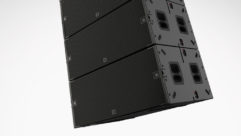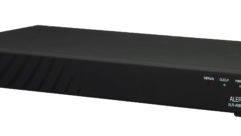HiQnet
Harman Pro aims for plug-and-play audio with its newly released connectivity and control protocol.
In mid-January, audio giant Harman Pro brought more than 400 audio industry luminaries together, including members of its international sales force as well as consultants, contractors, and members of the industry trade press, to let them in on more than a little secret that’s been five years in the making. Betting that AV professionals are fed up with having to learn multiple applications to set up and manage audio installations, the company unveiled a new technology called HiQnet. A connectivity and control protocol that works with any Harman product, HiQnet makes all components manageable through a single PC-based application, Harman Pro System Architect.
Because the pro audio industry currently has so few standards, time will have to tell what kind of reception HiQnet gets from the marketplace. For now, there’s no question the company has a lot riding on it.
Touting HiQnet as the most significant new technology introduction in its history, Mark Terry, president of the Harman Pro Group, made it clear that this is not just some science project. “Every acquisition has been driven by this vision, every research effort influenced by it, and every product development informed by it,” he said in a recent press release.
Calling it the “tipping point” that will enable Harman to achieve a multi-brand strategy, HiQnet enables true integration of seven brands through a networking solution that promises to facilitate an “all-Harman” solution.
“It’s not uncommon now at a typical job site that if you’re using a lot of different digital products, you’re using four or five different computer programs,” says Rick Kreifeldt, vice president of the System Development and Integration Group at Harman Pro, based in Salt Lake City. “I’ve seen as many as seven. They’re trying to hop between them. You have to remember which commands to do in each product. It’s a heck of a lot of stuff to learn.”
With HiQnet, audio professionals have to learn only a single application to configure, manage, and troubleshoot products such as mics, mixing consoles, and loudspeakers — provided they’re all from the Harman family of products and outfitted with support for HiQnet. Other features include:
- The ability to create a configuration and then apply those settings to all products in the system.
- All products report events and errors to a central log file.
- Support for a variety of connection types, including Ethernet, serial, and USB.
- Compatibility with Universal Plug and Play (UPnP), a networking standard widely used in homes and enterprises.
- The ability to copy and paste parameters from one product to another.
- Consoles, such as the Studer Vista 8, have a configurable cue list, enabling recall of presets on all connected products.
- JBL speaker DSP tuning files can be loaded into other products to ensure consistency.
- Although HiQnet is designed for pro applications, its basic concept is borrowed from the consumer world. “The consumer model that we’re aiming for is home networking,” Kreifeldt says. “Four or five years ago, it was a daunting task to network a few computers. Now it’s pretty trivial to go through some wizards and set it up.”In an effort to duplicate that ease, Harman made HiQnet compatible with UPnP, an architecture that fosters interoperability. Backed by more than 700 manufacturers of products such as computers, consumer electronics, and home security, UPnP is a network- and operating system-agnostic framework that enables peer-to-peer connections between devices. (More information about UPnP is available at www.upnp.org.) “All of our products adhere to those standards,” Kreifeldt says.Out-of-box experienceHiQnet aims to streamline the installation process by eliminating the need to configure the network settings in each product. With HiQnet, Harman says, integrators simply unbox the products, attach them to the network, plug in a laptop or tablet PC, and within a few seconds have control over every product. For example, a system-wide preset can be used to configure or reconfigure all HiQnet products at once.HiQnet is designed to work with a variety of network designs, such as subnets, and security measures including firewalls. It also scales up to work with systems using dozens of boxes. A major asset is the ability to sense the connection types used in an audio system. Harman says it enabled that intelligence by creating drivers that work with any standardized network protocol, including Ethernet, serial, and USB.
HiQnet
Harman Pro aims for plug-and-play audio with its newly released connectivity and control protocol.
CobraNet redux?Keep it in the family
Harman is marketing HiQnet partly as a way to reduce time and installation costs. For example, by routing all audio and control data over a common pipe, HiQnet aims to reduce complexity. Even so, the integrator still has some flexibility, depending on the product.
“On the VERTEC DP-CN powered loudspeaker, you can use one cable for both audio and control,” Kreifeldt says. “On the dbx DriveRack 4800, you can either use one cable for audio and control, or you can separate audio and control onto two different networks, with your audio isolated on a discrete network for maximum performance.”
HiQnet also aims to help with troubleshooting. Suppose an integrator is setting up a system where each product requires a separate application running on a PC. Outside of a HiQnet environment, the applications might not be able to run simultaneously. Having to run each application individually can be a hassle, but it’s even worse if two or more products are having problems — and their applications can’t be run simultaneously during troubleshooting.
HiQnet alleviates those types of situations by making all of the products report to a single error log rather than forcing the integrator to hunt through multiple applications in a quest for the problem’s source. There’s also no control system programming involved when using all Harman family products, which can save project time and expense. “With HiQnet, you need to understand only one protocol to control a complete system,” Kreifeldt says.
At first blush, HiQnet sounds a lot like CobraNet, the standard used for transporting audio and control data. Many equipment manufacturers have licensed CobraNet, whose features include the ability to run control and monitoring information and multi-channel audio from different manufacturers’ audio equipment over the same Ethernet pipe.
But HiQnet isn’t a souped-up version of CobraNet. “We didn’t take CobraNet, license it, change it to suit our needs and say, ‘Now it’s better,’ even though that was an option,” Kreifeldt says.
In installations using CobraNet, HiQnet rides alongside. “We said: ‘It’s the audio transport. Let’s keep it standard so that if someone is using a non-HiQnet product, they can still interface, at least at an audio level,’” Kreifeldt says. “We have control packets that are going along with CobraNet that make it more plug and play than CobraNet traditionally is. CobraNet has numerous little things you’ve got to get right for product “A” to talk to product “B.” We’ve got ways to automate those so that it’s much more plug and play.”
HiQnet also doesn’t add latency, so it shouldn’t be a problem for live sound. “You’re dealing with whatever latency is in the underlying audio technology,” Kreifeldt says. “We’re just wrapping it around that.”
HiQnet has a few noteworthy limitations. One is that it’s currently audio-centric, although support for video is a future possibility.
The same applies to audio products from outside the Harman family: If HiQnet is used in a multi-vendor installation, only Harman products are visible and manageable. That caveat could be a turn-off for integrators who need the freedom to pick the vendor whose product offers the price or performance that matches the job’s specs. For them, HiQnet’s value boils down to whether the ability to control all Harman gear on a single screen is worth limiting their product options to only Harman products.
One way for Harman to knock down that potential barrier to adoption is to license HiQnet to other vendors, “Right now, there aren’t any plans, but we haven’t ruled it out in the future,” Kreifeldt says.
Even staying within the Harman Pro Group family isn’t a guarantee because products already in the field might not be upgradeable to support HiQnet. The initial crop of devices shipping with built-in HiQnet support includes:
- AKG Acoustics’ WMS 4000 wireless microphone system,
- BSS’ Soundweb London,
- Crown International’s I-Tech amplifiers and PIP cards,
- dbx’ ZonePro range and DriveRack 4800,
- JBL Professional’s VERTEC DP Series, and
- Studer’s Vista 8 digital console.
- HiQnet also is at the mercy of the network technology. “For example, we can’t really sense analog connections or AES/EBU connections because they don’t provide the right mechanisms,” Kreifeldt says. “Using more sophisticated digital audio transports, we can sense the connection type.”Are standards important?A plug-and-play environment — where users don’t have to struggle to connect devices, even disparate ones — is a noble cause, but it’s easier said than done. It’s worth remembering how home networking reached that point: Open standards — such as IEEE 802.11 — trumped proprietary ones. Granted, it helped that major players such as Microsoft started backing open standards, but ultimately it was these open standards themselves, rather than a single vendor, that made interoperability the norm.“It’s the common theme in any industry to use technology to knit together product lines, and exclude or disadvantage products from other manufacturers,” says Michael Karagosian, president of MKPE Consulting, a Los Angeles-based firm specializing in theme park show control and AV system development. “At the other end of the pole, there are those who seek wide interoperability among equipment from many manufacturers, particularly since the economics of undertaking such developments can’t be borne by small companies. Perhaps Harman’s move will encourage more technology collaboration among its competitors.”Unlike an open standard, HiQnet limits users to the Harman family of products — an example of how ease-of-use benefits Harman as much as it does AV professionals. “At the end of the day, let’s face it: We’re trying to sell products,” Kreifeldt says. “The way you sell products is to make life easier for the installer. That’s one benefit that we’re trying to bring.”There’s also the question of whether pro audio is receptive to standards, if only because the sector currently has so few. Time will tell whether HiQnet is able to overcome that situation.“We can’t knock Harman for trying to be the Microsoft of audio, but we can hope it will encourage more Linux/open source-like activity among Harman’s competitors,” Karagosian says. “Or Cirrus can take it as bait to beef up CobraNet, which is not an open-source solution, but at least openly licensed. Either way, the stakes are raised, and a balance should be sought.”Tim Kridel is a freelance writer and analyst who covers telecom and technology. He’s based in Kansas City and can be reached at [email protected].









